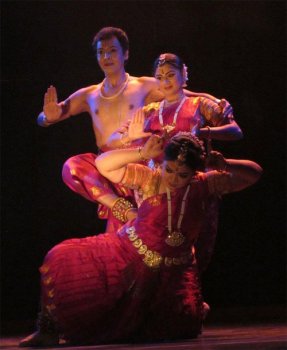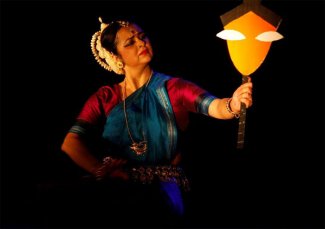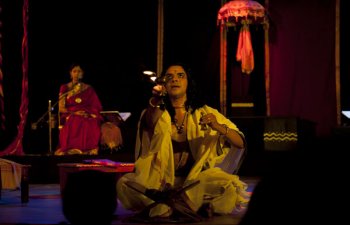
|   |

|   |
15th National Festival of Creative Arts - Dr Sunil Kothari e-mail: sunilkothari1933@gmail.com March 30, 2013 I am a great admirer of Bijon Mukherjee, an indefatigable organizer, art lover and never-say-die enthusiast, who after retiring from Indian Council for Cultural Relations (ICCR), upon a suggestion of Lalit Mansingh, the then Director General of ICCR, started an institution Impresario India, presenting group choreographic works in 'National Festival of New Dance Choreography' annually. For the past 14 years, Bijon-da has organized several other functions covering Rabindra Sangeet, recitation of poetry, plays, folk dances and what have you. He cast his net wide and encouraged several artistes. The annual National Festival of New Dance Choreography became extremely popular and brought to the Capital senior and young choreographers with their new group works, in different dance forms, including Sattriya recently recognized as the eighth classical dance form. When I look back, I realize how Bijon-da with small beginnings, has created a national platform, managing (one never knows how on earth) funding, financial support and with amazing energy as a real impresario, year after year these festivals, offering to the connoisseurs and lay audiences alike such a feast of performing arts! In return, he has earned tremendous goodwill from the community of performing arts. Whenever I am in town, I never miss these events and attending the present festival under review was rewarded by excellent presentations. On the opening day, Lalit Mansingh, our former Ambassador to USA, High Commissioner to UK, foreign secretary in the Govt. of India and 'a real rasika' complimented Bijon-da "for widening the scope of this annual festival, to include other creative art forms as well." Now titled 'The National Festival of Creative Arts,' this year's festival scheduled from 20th March, offered a variety of performing and plastic arts including Pata Chitra on Swami Vivekananda by Rani Chitrakar of Medinipur, in the foyer of the Stein Auditorium of India Habitat Centre, New Delhi. The festival was dedicated to the memory of Swami Vivekananda to commemorate his 150th birth anniversary. And therefore on 21st March 'The Swami and the samaritan' a short play in English conceptualized by Dr. Ashish Ghosh and Ruma Ghosh dwelling upon the complexities of interaction between two powerful personalities Swami Vivekananda and Margaret Noble, who was later named Nivedita by Swami, was presented with great simplicity, few visuals and simple dialogues, much appreciated by the receptive audience. Largely based on Sister Nivedita's 'The Master as I saw Him' and letters, it depicted their meetings, inclined spiritually, but also often disagreed on many issues and often came into conflict. Interestingly resorting to folk performance traditions of Jatra with two interesting dramatis personae Vivek (Conscience) and Niyati (Destiny), who appeared from time to time to comment on the events and the deeds of the lead characters of the play, which ingeniously rhymed well with Vivekananda and Nivedita, it was a clever dramatic touch. Both Dr. Roma and Ashish Ghosh performed it well and movingly. An apt tribute to Swamiji.  Sankhya Dance Company Photo: Avinash Pasricha The sequence of duel with Mahishasura and Shakti was dramatic. Vaibhav as Mahishasura and female dancers as the multi-armed Goddess, evoking Goddess Durga's fierce form, Vaibhav's utplavnas, leaps, covering the stage won instant applause from the audience. In the earlier sequence, Vaibhav's stance as Lord Shiva and suggestively as Parvati, maintaining dignity, was praiseworthy. Rich in a variety of Bharatanatyam nritta movements Vaibhav as a choreographer gave one a glimpse into his rich imaginative approach. He also has commendable experience of having worked with actors in drama and theatre, and seems to have invested those elements coalescing artistically in his choreography. The philosophical moorings of the theme were projected well. The divine personality of godhead with two halves - the material and the spiritual, Purusha and Prakriti, Shiva as Ultimate Brahman, both Nirarakara, formless and Saguna-saakaara were woven throughout the dance in a telling manner. The presentation resonated with various layers, subtle and rich. The team work was exemplary.  Sharmila Biswas Photo: Avinash Pasricha On a proscenium stage, numbers like Treekayi, presenting the interaction of music, rhythm and dance, three entities, find an ideal venue. It would be invidious to single out any of her dancers for the excellence they have achieved under her watchful eye. Neelay Sen Gupta, inspite of his avoirdupois, has exquisite light quality in his dancing. The young vocalist Srijan is a real find, his singing sill rings in my ears. Sitting on the stage, surrounded by three female dancers, who get up and dance to his singing of Pallavi, on other side, the percussion player, also surrounded by female dancers, playing cymbals - all integrated visually, maintaining autonomy of music, rhythm and dance and was a sheer delight to relish. As Surparnakha, Sharmila brings to her depiction of the princess of Sri Lanka great charm and dignity. The Odiya text of Ramayana finds a felicitous expression in her abhinaya. Mature and subtle, suggestive and evocative, Sharmila's Surpanakha is a tour de force. Sharmila explores various facets of her character. The use of masks, holding them in hand, enriches the presentation visually. With the processional dance of Rathajatra-The Patuar, she concluded the performance. The finale with dancers showering flowers had ritualistic touch. One felt that though one has been watching Sharmila for a long time, she continues to surprise one with her solo and group choreographic works in Odissi with her ability to evolve new forms within the boundaries of Odissi dance, making uniquely contemporary statements through her works. Gowri Ramnarayan, playwright, director, veteran journalist, in recent years has taken to staging plays bringing together literature, theatre, dance and music. She used to accompany legendary vocalist MS Subbulakshmi for singing. Her musical sensibilities endow her production with richness. In production under review, Gowri has received live vocal support from sweet voiced Nisha Rajgopal, whose Carnatic singing throughout the play, binds the unfolding of the drama, story, enactment of dance, dialogues in an absolutely spellbinding manner.  Sarpa Sutra courtesy JustUS Repertory Sarpa Sutra is an allegorical revenge cycle that mirrors our lives and times. Gowri has imaginatively and with deft directorial touches interwoven two versions of the same story, one by Veda Vyas (Sanskrit) and other by a sardonic Arun Kolhatkar, the Maharashtrian poet (English) with her own inputs and comments. The story is well known from the Mahabharata: the burning of the Khandava forest by Arjuna, revenge by serpent king Takshaka, who bites Arjuna's grandson Parikshita and so on. Then Parikshita's son Janmejaya performs sacrifice to destroy the whole race of snakes, but serpent woman Jaratkar, mother of Astika urges him to stop the genocide. The theatre as conceived by Gowri makes the spectators ask question: Can Astika save the planet? The play resonates with subtext. Genocide in present times, the attempts at annihilation of mankind by fundamentalists, terrorists and various political realities start arousing reactions in the audience. Even when the allegory is from the epic, its message is conveyed artistically. Gowri sits in one corner, sometimes narrating as a female Sutradhara, sarcastically speaking of 'editing' manuscripts of Veda Vyasa, commenting on how old Brahmin men discard women, when Jaratkar as serpent woman, sister of Vasuki, is discarded. She enters into dialogue with the singer also as the play unfolds. Traversing easily from Sanskrit to other languages and English, the play has a rich texture of spoken words. The angikabhinaya for expression is well exploited. Multi-talented Sheejith Krishna, actor, dancer, choreographer, percussionist playing various roles, using his basic Bharatanatyam training, putting various scarves, impersonating different characters, performs with the ease of a seasoned dancer. He has a commanding stage presence. Bharatanatyam dancer Mythili Prakash assists in placing objects on stage, unobtrusively. Clever theatrical device. Lighting by Venkatesh Murugan, sound/audio projection by Gowri's daughter Akhila, and presentation under the banner of JustUs Repertory leave an indelible impression. Since I am used to watching Kalakshetra productions of Rukmini Devi's dance drama and Gowri and Sheejith have close connection with Kalakshetra, the aesthetic stage properties, costumes, et al, I enjoyed visually. The play begins with the chanting of 'Ahimsa paramo dharma' and also ends on that note conveying the message of non- violence. On account of many events taking place simultaneously, one at times finds it very difficult to attend such festivals for all the four days. The other two productions were 'Ram,' excerpts from the Bhavabhuti Ramayana directed by Anurupa Roy under the banner of Katkatha Puppets Arts Theatre, New Delhi, told through animation, projected images, dance, masks and puppets. It was followed by 'She,' a choreographic work by Sharmistha Mukherjee in Kathak, dealing with ancient goddesses like Aditi, Vak, Bhumi, Aranyani, Ratri and Usha. I happened to see it at Khajuraho Festival of dances and had enjoyed the energy of the young dancers and their Kathak technique. It would have been interesting to see it again in a different venue, as Khajuraho venue with a temple backdrop and another structure on stage had posed a few problems. Impresario India is to present in month of April through Hindi songs and visuals, the life and work of Swami Vivekananda by Sekhar Sen from Mumbai, also a theatrical dance composition in Kathak style by Rajashree Shirke and her disciples, a short Bengali comedy play Bhul Swarg based on Tagore's story, Leichan, a collection of Festivals dances of Manipur by Bimbavati Devi, daughter of Guru Bipin Singh from Kolkata, and Dwiju Babur Gaan, a collection of songs by DL Roy with narration by that nightingale Jayati Ghosh from New Delhi. A sumptuous fare. Bijon Mukherjee has by now earned a formidable reputation for presenting a cross section of artistic works and one looks forward to enjoying them.  Dr. Sunil Kothari is a dance historian, scholar, author and a renowned dance critic. He is Vice President of World Dance Alliance Asia Pacific India chapter, based in New Delhi. He is honored by the President of India with Padma Shri, Sangeet Natak Akademi award and Senior Critic Award from Dance Critics Association, NYC. He is a regular contributor to www.narthaki.com, the roving critic for monthly magazine Sruti and is a contributing editor of Nartanam for the past 12 years. Post your comments Pl provide your name and email id along with your comment. All appropriate comments posted with name and email id in the blog will also be featured in the site. |